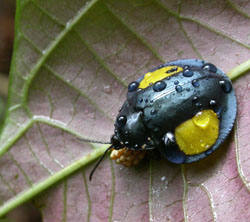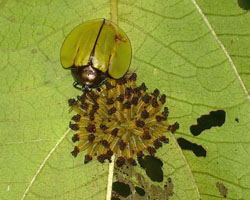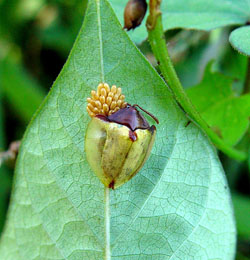Research shows usually solitary leaf beetles can act like helicopter moms
LAWRENCE — The instinct for mothers to protect and nurture offspring is rooted in more species than scientists have understood before now.
 In a new study published in the Journal of Natural History, University of Kansas researcher Caroline Chaboo details how some leaf beetles — a huge group of about 40,000 separate species that usually are solitary insects — show self-sacrificing maternal care for their young.
In a new study published in the Journal of Natural History, University of Kansas researcher Caroline Chaboo details how some leaf beetles — a huge group of about 40,000 separate species that usually are solitary insects — show self-sacrificing maternal care for their young.
"Maternal care is a phenomenal behavior, whether it's a beetle, a shark or a monkey," Chaboo said. "The investment of mothers with their time, their vigilance, their grooming and cleaning, finding and providing food, putting their own lives at risk, often not eating for themselves — it's remarkable that parental care is so one-sided."
 Dubbed by scientists as "subsociality," active parenting among leaf beetles is notable because the insects usually live out their lives alone, without the more complex social behavior seen in bees, ants, wasps and termites — which scientists call "eusociality."
Dubbed by scientists as "subsociality," active parenting among leaf beetles is notable because the insects usually live out their lives alone, without the more complex social behavior seen in bees, ants, wasps and termites — which scientists call "eusociality."
But the exception to the loner's life of a beetle is motherhood, where the solitary insects become more like "helicopter moms."
 "A leaf beetle mother will keep an eye on the eggs, grooming and guarding them," Chaboo said. "She will oversee her herd of larvae as they eat, while she keeps watch for flying attackers, like wasps, and also pedestrian attackers, like ants. She moves between the attacker and the babies, and will stamp her foot and try to shoo off the intruder."
"A leaf beetle mother will keep an eye on the eggs, grooming and guarding them," Chaboo said. "She will oversee her herd of larvae as they eat, while she keeps watch for flying attackers, like wasps, and also pedestrian attackers, like ants. She moves between the attacker and the babies, and will stamp her foot and try to shoo off the intruder."
The leaf beetle's active mothering is critical to the survivability of the next generation, according to Chaboo.
"If she is removed or lost, all the babies die," she said. "It’s pretty crucial that she is around to ensure some of the offspring survive and reach adulthood."
After a century of research focus on eusociality by William Morton Wheeler, Susan Batra, Edward O. Wilson and KU's own Charles Michener, James Costa brought focus to the poorly known phenomenon of beetle subsociality with his 2006 book, "The Other Insect Societies." Chaboo worked to expand knowledge of leaf beetle parenting with her own fieldwork and an extensive review of literature.
"Leaf beetles have fascinated me since I first looked at these extremely colorful beautiful beetles in a museum drawer," said the KU researcher. "During fieldwork in my native country, Trinidad, I found female leaf beetles guarding their babies. This discovery led me to start pulling on the thread. I was already writing this new paper when Costa's book appeared. To make a truly paradigmatic shift in research on leaf beetle subsociality, I needed to make the paper synthetic by pursuing every bit of what we may already know about parental care in leaf beetles, more comprehensive by pursuing more fieldwork to discover species I suspected were subsocial, and more paradigmatic by developing evolutionary models to organize the information we have and to accelerate future research."
Indeed, Chaboo's paper on leaf beetle subsociality has received praise from fellow scientists for its comprehensiveness and new insights into how insects' social lives have contributed to their evolution.
"It’s an important paper, because it extends the records of subsociality in insects and in particular in the Coleoptera," said Bert Hölldobler, the Pulitzer Prize-winning evolutionary biologist at Arizona State University, using the scientific name for beetles. "Subsociality is generally considered the evolutionary precursor of eusociality, which is so prevalent in ants, and some bee and wasp species and termites. But there are also some beetle species known that have evolved eusociality. The kind of work Caroline has just published is extremely important for all of us who want to understand the evolution of social life on this planet.”
In addition to the extensive literature review, Chaboo and her colleagues spent countless hours in the field, discovering many species with subsociality.
"We're searching for species in tropical forest habitats — the needle in the haystack," Chaboo said. "Even though we had educated guesses on the host plants, it is still serendipitous when a subsocial species is discovered. My co-authors, Rob Westerduijn in northern Peru and Fernando Frieiro-Costa in Brazil, have more frequent access to the habitats and are walking the trails a lot. Each new species we report represents tenacious work — to search out the plants, turn over leaves, scan vegetation for mothers and babies, and keep returning to study the behaviors."
Chaboo’s own fieldwork took her to Panama, Costa Rica, Nicaragua, Trinidad and Peru. She says that in the midst of the research she gained even more understanding of the maternal instinct common to so many species by becoming a mother herself.
"During the course of writing this paper, my co-author Jesus Gómez-Zurita in Spain and I each had a child," she said. "I think our respect for these leaf beetle mothers grew enormously with our own experience as first-time parents."